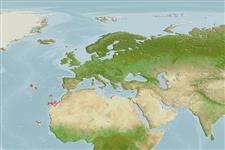Klassifizierung / Names
Namen | Synonyme | Catalog of Fishes(Gattung, Arten) | ITIS | CoL | WoRMS | Cloffa
Issue
Will eventually be assigned to a new genus.
Environment: milieu / climate zone / Tiefenbereich / distribution range
Ökologie
seewasser riff-verbunden; standorttreu; tiefenbereich 0 - 25 m. Subtropical; 40°N - 13°N, 29°W - 11°W (Ref. 56021)
Eastern Atlantic: including Madeira, Azores, Ilheus Selvagens, Canary Islands, Cape Verde, and Senegal.
Size / Gewicht / Alter
Geschlechtsreife: Lm ? range ? - ? cm
Max length : 15.0 cm TL Männchen/unbestimmt; (Ref. 27000)
Rückenflossenstacheln (insgesamt) : 13; Rückenflossenweichstrahlen (insgesamt) : 16 - 17; Afterflossenstacheln: 2; Afterflossenweichstrahlen: 13 - 14.
Body shape (shape guide): fusiform / normal; Cross section: compressed.
Adults inhabit rocky inshore areas, often near sand; juveniles found in tide pools. Food comprised mainly of algae with associated minute invertebrates (Ref. 6760). Males protect the eggs deposited in nests (Ref. 6760).
Life cycle and mating behavior
Geschlechtsreife | Fortpflanzung | Ablaichen | Eier | Fecundity | Larven
Oviparous, distinct pairing during breeding (Ref. 205). Eggs are demersal and adhere to the substrate (Ref. 205). Males protect the eggs deposited in nests (Ref. 6760).
Allen, G.R., 1991. Damselfishes of the world. Mergus Publishers, Melle, Germany. 271 p. (Ref. 7247)
IUCN Rote Liste Status (Ref. 130435: Version 2025-1)
Bedrohung für Menschen
Harmless
Nutzung durch Menschen
Tools
Zusatzinformationen
Download XML
Internet Quellen
Estimates based on models
Preferred temperature (Ref.
123201): 18.7 - 24.5, mean 20.2 °C (based on 85 cells).
Phylogenetic diversity index (Ref.
82804): PD
50 = 0.7500 [Uniqueness, from 0.5 = low to 2.0 = high].
Bayesian length-weight: a=0.01259 (0.00497 - 0.03190), b=3.04 (2.82 - 3.26), in cm total length, based on LWR estimates for this (Sub)family-body shape (Ref.
93245).
Trophic level (Ref.
69278): 3.5 ±0.14 se; based on food items.
Widerstandsfähigkeit (Ref.
120179): hoch, Verdopplung der Population dauert weniger als 15 Monate. (Preliminary K or Fecundity.).
Fishing Vulnerability (Ref.
59153): Low vulnerability (10 of 100).
🛈
Climate Vulnerability (Ref.
125649): High to very high vulnerability (71 of 100).
🛈
Nutrients (Ref.
124155): Calcium = 54.3 [24.9, 116.4] mg/100g; Iron = 0.693 [0.403, 1.170] mg/100g; Protein = 19.7 [18.7, 20.7] %; Omega3 = 0.234 [0.135, 0.397] g/100g; Selenium = 10.1 [4.9, 20.4] μg/100g; VitaminA = 85.5 [28.8, 262.9] μg/100g; Zinc = 1.07 [0.69, 1.62] mg/100g (wet weight);
